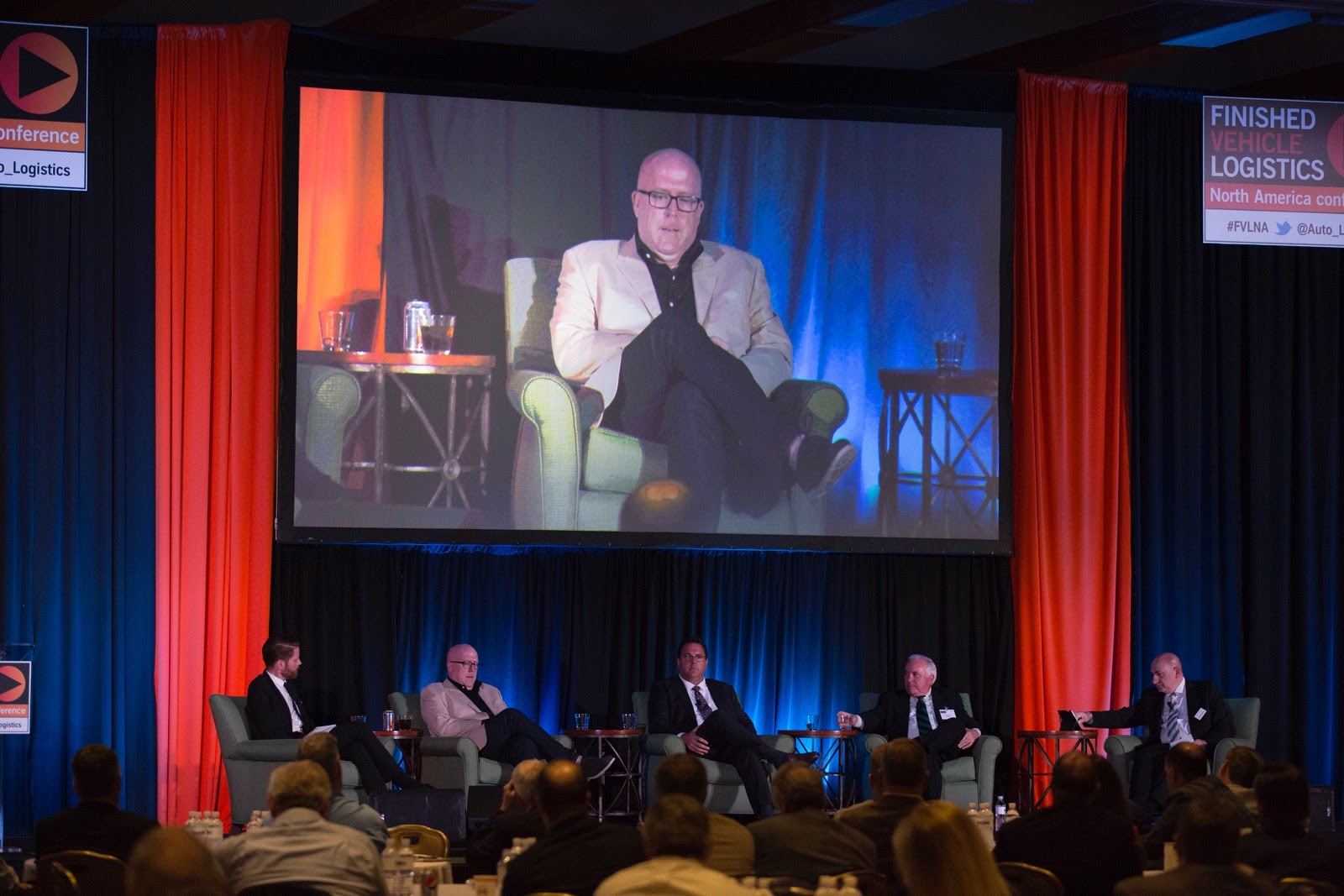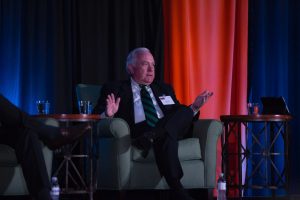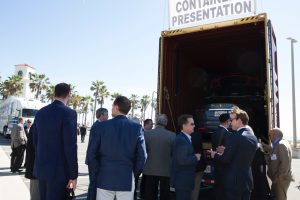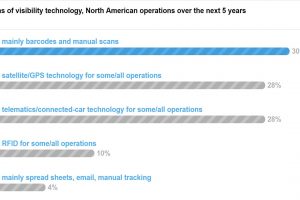The eighth annual Finished Vehicle Logistics North America conference discussed lots of potential for connected car and in-vehicle technology to transform transport and tracking. However, uncertainties over which technology to focus on, as well as regulatory and economic questions, may hold back important software and hardware updates. Marcus Williams reports from Huntington Beach, California.Gareth Tredway and Christopher Ludwig contributed to this report
Digital technology is turning the car into something it has never been before. Vehicles are fast becoming 'connected devices' in the Internet of Things and, as such, disruptive to the automotive industry itself. While the car has long been more than a means of transport, today it is increasingly a centre of communication, shopping and engagement, and will be even more so as it increasingly drives, navigates and even repairs itself. All this technology is increasingly changing the way the car is built, sold, used and maintained.
So, too, might it change the way it is shipped and delivered in the outbound supply chain. With vehicles increasingly laden with sensors and telematics, the potential for tracking and tracing their every move seems obvious. Meanwhile, autonomy could also change handling, loading and movement in yards and ports, and even routing through networks. Might much of today’s vehicle logistics industry see disruption from the very product it was designed to serve?
In this report:
However, not everyone is quite sure whether or not in-vehicle connectivity should be the immediate focus of outbound logistics managers and providers. Questions remain about the impacts of a vehicle’s battery, about data security, about how such technology would integrate into existing processes and systems across plants and distribution centres, among other concerns. Other executives also question how much visibility is too much. Does the customer or the dealer, for example, really need to know that a car is waiting at a rail-switching yard in Kansas or Colorado, or waiting at a port in Germany for a sailing? Is it enough to provide an accurate delivery day and keep to it?
Or, is thinking about the impact of such technology on tracking final delivery too narrow, given the potential changes up and down the sector, from vehicle ownership models to data management?
These were questions debated at this year’s Finished Vehicle Logistics North America conference in Huntington Beach, California, as delegates grappled over what digitalisation and autonomy will mean over the coming years. In some cases, it may be that uncertainty about which technology will take hold is leading companies to hold back on investments, whether in exploiting in-car systems, or in other technology such as RFID. The conference offered examples that showed the industry moving in multiple directions.
Questions around such technology in future also come as the North American industry continues at an all-time high in vehicle sales and production, following yet another record sales high in 2016. But there are signs – including rising vehicle inventory and incentives – that the sector is headed for a pullback or decline. The policy impacts of the new administration of Donald Trump, including for the North American Free Trade Agreement (Nafta), as well as plans for economic stimulus and infrastructure investment, raise further questions.[sta_anchor id="1"]
On the verge of true telematicsTelematics, which combines GPS data with on-board diagnostics to record and map exactly where a car is and what it is doing, has been in some vehicles for 15-20 years – GM’s OnStar system was first rolled out in the 1990s. Legislation put to Congress late last year, meanwhile, will mandate such tracking to be in every vehicle for safety reasons in the near future.
As this technology becomes ubiquitous, it could change how cars are tracked, validated and autonomously participate in the delivery process, according to experts. On the horizon, meanwhile is the so-called 'cognitive car', able not only to drive itself but also to learn and interact with the surrounding environment, and to influence its own delivery.
Short-range, vehicle-to-vehicle (V2V) technology already exists, according to Chris Wilson, director of CW Consulting, a technology specialist who worked more than 20 years implementing connected car technology with Mercedes-Benz. He said it had further potential to create an information environment in which vehicle and device makers could create and implement applications to improve safety, mobility and the environment. Wilson suggested that there was considerable potential for such equipment to be used across vehicle handling and transport.
Further reporting and content from the conference
- OEMs with US capacity best placed ahead of any Nafta changes
- WWL and Nissan implement RFID in Mississippi
- Honda overcomes Mexican damage for some flows
- High tech over brute force in reducing vandalism in Mexico
- Live polling results
In North America, while interest is rising, there appears to be some reluctance to move to this technology. FCA’s Brazeau admitted that that while there was uncertainty among service providers about the direction they should go, although he thought it was a lot clearer than it was even last year – from FCA's point of view, in-vehicle technology will unlock value for vehicle logistics. He warned that industry players should be careful not to repeat the mistake Nokia made in 2005 when it drew up its five-year plan and failed to forecast the arrival of the smartphone in 2007, when Apple launched the iPhone.
“If you are looking at anything that doesn't satisfy a future vision where the vehicle was the disrupter and the proactive source of data, then I would think you are considering more a bridge technology and you are betting on something that may or may not be around in a couple of years,” Brazeau said.
Others agreed with Brazeau that in-vehicle telematics would change vehicle logistics. Tom Swennes, vice-president strategic planning and administration at ICL Systems, predicted that telematics represented the best opportunities for vehicle transport and yard management, and suggested that it would achieve what RFID promised but failed to deliver over the past decade or more.
John Felitto, chief executive officer of WWL VSA, the inland services division of Wallenius Wilhelmsen Logistics in North America, said that the future was really about telematics and the need to connect to the rich level of information in the car – even though the provider is the process of investing in an RFID solution with Nissan. “Telematics is becoming more popular,” he said. “If we could link to the constant signal in the car this is where the future is.”
Mark Anderson, president of vehicle haulier United Road, also acknowledged that telematics offered a rich source of information for vehicle logistics, especially when exploited in the trucks used to deliver cars.
“There is so much information in telematics that you can use,” said Anderson. “It is about safe driving and being able to predict the behaviour of your drivers. It is also about the positioning and being able to predict when your asset will get to its location. Again, with things like time management and GPS data, algorithms and automated load building tools, it all breeds efficiency, more lane miles, happier drivers and overall just a more efficient network from the final mile perspective.”[sta_anchor id="2"]

What to invest in and whenHowever, whether there is value in making real-time vehicle location and status data available more widely was called into question by some OEMs. Gerald Lee, vice-president of vehicle planning and logistics at Subaru, pointed out that constant updates tended to lead to many questions that weren’t always relevant to the final delivery.
“I thought that [telematics] was a great feature and it would unleash the data to the dealers. But as we got closer to it becoming a reality, I became afraid that there were so many questions coming from the dealers based on that information that I would have to triple [the size of] my department,” he said.
Lee said that Subaru achieves 95% accuracy on the estimated time of arrival of vehicles that it provides to dealers – a level higher than most carmakers in the built-to-stock US market. He suggested that such accuracy was probably enough and any more information could lead to more problems that it solved.
Others at the conference also expressed doubts over which technology to pursue, including worries over whether decisions made today would quickly become obsolete. “From our perspective we always look at if the investment is going to [provide a] return on the bottom line and, with the tech changing so quick, one of our concerns would be that if it is a five-year return and the technology is only useful for three, it is not a good decision,” said Glenn Clift, chief executive officer at Glovis Americas, the logistics division of Hyundai Motor.
Clift also made the point that the customer was not going to contribute to that cost. “Us being able to find a car a bit quicker doesn't justify [higher costs],” he said. “Saving half a day on average may not be worth the investment. We keep studying it and looking for better ways, but we just haven't pulled the trigger on any serious technology for that.”
However, providers need to pull the trigger soon, according to Tom Swennes from ICL. He admitted that putting together and making use of all the data in-vehicle technology will produce is going to require new systems and investment, but risks are going to have to be made. That is because the greater risk is in waiting for the dust to settle and missing opportunities. That had been the case with RFID over the past decade or more, which, despite now being more cost effective, never really took hold in the vehicle supply chain.
Daniel Gosson, consultant at software and technology provider, Inform, also suggested that RFID was dead because the industry had waited too long to implement it. Instead, Gosson pointed again to telematics and autonomous vehicle functions, highlighting that investment concerns were mitigated, while also pointing to the applications for the delivery trucks.
“What we need to do is leverage consumer functionalities like telematics and autonomous driving and bring them into the finished vehicle logistics world because there is no buy-in cost. It is not RFID where we have to have all of these extra systems on top to make use of it,” said Gosson.
However, providers and OEMs continue to explore a variety of technologies that may be used alongside existing systems that rely on barcode scanning – including RFID. John Felitto revealed that WWL VSA is using passive RFID tags in a new project with technology expert Surgere to manage Nissan vehicles out of its Mississippi plant in Canton. The project has already mapped the entire facility, including 6,000 bays with GPS co-ordinates. And WWL has ambitions to use the technology across the more-than 5m vehicles it manages in North America.
 Subaru's Gerald Lee questioned how much visibility was too much visibility
Subaru's Gerald Lee questioned how much visibility was too much visibility“We will then be able to scan all the units in and out of the facility, and we will be able to take inventory using a scanner,” said Felitto. “We are investing in the tags and the technology that Surgere is providing but Nissan needs to invest in the infrastructure at the plant.”
Felitto said the project was just starting out and would take time to be fully up and running but the “pretty sizable investment” would see a return in the savings made by a more efficient process.
Clift added that Glovis uses RFID in some facilities in conjunction with barcode scanning; once a vehicle is scanned, the information is recorded using RFID and prevents the need for manual entry. However, manual scans of each vehicle are still necessary, and Glovis currently has no plans to change this.
Electronic live polls taken at the conference confirmed the mixed picture for technology, and the prevalence for entrenched systems – 60% of respondents said their transport and yard management systems were five years old or older, while only 21% were less than two years old. Among technologies predicted in use in five years' time, respondents were split fairly equally between still using barcode scanning primarily, shifting more to telematics, or to GPS, while fewer anticipated using RFID.
Nevertheless, some feel strongly that mobile-based technology will eventually win the race for vehicle logistics. Gosson at Inform suggested that mobile apps could be used to track incoming trucks with real time tracking, for example, processes that the company was already using for inbound logistics, including with Audi in Germany. That, and the ability to use geo-fencing to generate ETAs, meant workers at the handling facilities could be in place and ready to load or offload vehicles. He also said telematics' ability to remove the need for physical battery and tyre checks could reduce damage because fewer people would be touching the car.
“You are also able to shift to predictive data analysis and you have better planning and optimisation,” Gosson added. “So really there are a lot of benefits to utilising this technology within yards and in transit.”
Swennes also pointed to the potential of connecting other equipment in the outbound chain. For example, vehicle-carrying railcars could transmit low-power messages about location and condition, which would be important since rail is often a blind spot in the delivery tracking process.[sta_anchor id="3"]
Barriers aheadSwennes acknowledged that many challenges remain to carmakers and logistics providers adapting telematics into their processes. While there may be lower start-up costs, there was a lot of technology that had to be worked out to realise the end-to-end capabilities, including the infrastructure and data protocols, and the differing standards applied. There are also questions over whether engineers and code writers would be willing to add in features relevant to vehicle logistics into a car’s lines of code, which already number some 100m lines.
One of the other sticking points is battery drain, as many worry that a greater reliance on telematics to fulfil a wider range of vehicle delivery functions could harm a car's battery life.
“With the vehicles having the technology they have, it sure would be nice to tap into that, but battery life in the vehicle is a big concern,” said Glenn Clift at Glovis America. “We already have concerns without those vehicles being hooked up all the time.”
 Connected car expert Chris Wilson saw many applications for new vehicle technology and outbound distribution
Connected car expert Chris Wilson saw many applications for new vehicle technology and outbound distributionStuart Kessler, port operations manager at Volkswagen Group of America, also had concerns over battery drain, whether it was telematics or RFID. “If you don't solve the ability to keep the battery charged the cars can't drive [with or without driver] and that will be the biggest challenge,” he said. “How do you have something stop running and what does that do to your system at 30% of your production when it physically won't start? All of your processes become ineffective. The biggest challenges is how do we keep the physical battery capable of starting and using the autonomous capability.”
Brian Mason, vice-president planning, analysis and development at Pasha Automotive Services, also expressed concerns with battery drain. “With telematics on long storage vehicles you want telematics shutting down to save the battery,” he said, “but that is an engineering challenge. You don't want it to drain the vehicle so you are having to recharge it.”
Others, by contrast, thought the battery question had been solved. “The barriers to [telematics] such as battery life are beginning to fall away,” said Swennes. “That point was to do with whether the telematics was on all the time or whether it could be triggered when needed. The OEMs we talk to say the battery problem is behind them.”
Chris Wilson asked why users simply couldn't tell the car to start itself – as many cars now have that function by mobile phone – and thus recharge the battery.
The greater use of telematics also raised the prospect of data security, something Wilson was more concerned about, describing it as a huge issue. Wilson said anonymity needed to be mandated to avoid hacking and that encryption was already at “nuclear level” security. While many OEMs were not as concerned about one vehicle being hacked, a virus propagating through a whole data system was a big concern.
While data used to personalise the vehicle by the individual would be owned by him or her, there were wider questions for the industry when that data became aggregated at a higher level and what could be done with it.
“Everyone realises this aggregated data is valuable but no one quite knows how valuable,” said Wilson. He said OEMs were trying to figure out how much it could be worth. “It is an interesting dynamic about who is going to sell the data and how it should be packaged, but at that point it is anonymous,” he said.[sta_anchor id="4"]
Big data deliveryJohn Felitto acknowledged that connectivity and digitalisation have “sky-rocketed” to the number one key trend. Quoting findings from research analysts GMI and IHS-Markit, Felitto said that 84% of automotive executives now agreed that data was the fuel for the future business model of automotive companies.
Ben Stanley, global automotive leader at the Institute for Business Value, a consultancy division of IBM, also stressed the importance of data. He said the autonomous car would generate and consume 4,000gb of data every eight hours, which is equal to the data of 3,000 people. That means 1m autonomous cars would generate data equivalent to 3 billion people every day.
“There is a huge amount of data from which you can learn and applying analytics on all of that data will provide better [logistics] services,” said Stanley.
Felitto said the next step would be to take autonomous and connected car developments, such as auto piloting and parking, and applying the technology to logistics.
Chris Wilson pointed to a remote parking app available from Mercedes-Benz as an example of technology that could be used for yard management, not least because it allowed more compact parking and removed the need for drivers to risk damaging the cars by squeezing into tight spaces.
He also pointed to automated valet parking technology in which vehicles parked themselves using a range of sensors that picked up cues from the garage infrastructure as well as in-car responses to people and objects. Wilson pointed out that the cargo deck of a pure car and truck carrier (PCTC) was like a garage; with some upgrades to the technology, the system was directly applicable.
Bill Kerrigan, vice-president of logistics at port processor SSA Marine, foresaw a time when autonomous vehicles would lead to similar automation at vehicle-handling ports as seen today at container terminals. “On 13 decks of a PCTC you could have a longitude and latitude point for every car on that ship, and at some point in the future those cars can be driven on and off with no people in them,” he said.
Such technology would change labour needs and require a transition of workers, like in the container business, to more monitoring and planning roles. “We would have more time to plan the yards and the vessel loads and discharges.”
Felitto also pointed to robotics and autonomous vehicles in the inventory management process and said WWL VSA was committed to test the applications of the technology. While its current RFID project with Nissan would still use manual scanning, for example, in future a robot or drone could do that.
 Glenn Clift from Glovis said that new technology needed to justify its cost, while noting that customers would probably not pay extra for faster logistics
Glenn Clift from Glovis said that new technology needed to justify its cost, while noting that customers would probably not pay extra for faster logisticsThe US's largest vehicle haulier, Jack Cooper Transport, was also catching up with developments. Alex Meza, the new president of Jack Cooper Transport, said the company was looking at truck platooning, driverless yard management, and the individual self-delivery of cars. “With the driverless yard management you have resource gains such as the better cube on yard capacity because people don't need to get in our out of the vehicles,” he noted.
Meza also pointed other technology already in use, such as electronic proof of delivery (ePOD), as well as a network optimisation tool for its fleet. “We partnered with a company to create an algorithm and it does the job,” said Meza. “It runs twice a day and takes the fleet real time data and minimises empty miles. As our engineers have tweaked the model we have 97% acceptance of it from our customers.
“Putting massive amounts of data through a process to analyse it was worth the time,” he added.
Along with autonomous and connected vehicles, another game changer could be cognitive technology in cars, according to Ben Stanley at IBM. Cognitive vehicles would be able to understand imagery, language and other unstructured data much like humans do. In future vehicles would be able to learn, interact and extract ideas from the surrounding environment and their own performance.
Stanley said such vehicles could be active participants in their own movement; that could include interacting with transport vehicles and logistics management systems, preventing handling or routing mistakes, and learning through cognitive participation to recommend improvements to the delivery process. The application of the technology in the truck even had the potential to recognise the driver, find and suggest parking spots, and monitor the performance and health of the driver.
While such uses may take some time to be safe enough for more complex traffic situations, more immediately there were applications in controlled environments, exactly like a vehicle storage yard at a plant or port terminal storage facility, according to Stanley. Furthermore, such vehicles would be able capture and report problems or damage, and even heal themselves to some extent, whether it be with software updates or paint repair, opening up some interesting prospects for the quality assurance part of the business.[sta_anchor id="5"]
Uncertainty aheadAll this technological development promises potential change. But it is not yet the reality on the ground in vehicle yards and terminals today, where the main issue for many operators remains space and capacity constraints.
Following seven straight years of growth and a record 17.58m light vehicle sales in the US last year, as well as strong sales and production across Mexico and Canada as well, the sector has maintained a high pace of volume. While sales have shown mild decline year-on-year in the first two months of the year, the adjusted seasonal sales rate remains high. However, Brandon Mason, director of PwC’s global automotive practice, predicted that sales will decline for the next few years, perhaps to as low as 16.3m units by 2019, before recovering back close to current levels thereafter.
The full impact, meanwhile, of any renegotiation of Nafta – and how it would relate to automotive trade with Canada or Mexico – remain far from clear, as outcomes or even the precise intentions from the US government are murky at best. Brandon Mason acknowledged that the imposition of tariffs or of a border tax, however, could lead to price increases and potential declines in sales.
The reality and impact of Trump’s $1 trillion infrastructure investment pledge, meanwhile, would be welcome to many in the logistics industry. However, the shape it which eventually take is also unclear. According to Scott Davies, director of the office of marine Highways and passenger services at the US Department of Transportation Maritime Administration, there is talk in Washington DC of a new infrastructure packaging being presented later this spring. In the meantime, Davies said that there are federal programmes that could support vehicle logistics operations ranging from ro-ro ports to inland waters, including TIGER grants and low-interest loans, but most were heavily oversubscribed.
For now, until policy becomes clearer, Mason signalled a more immediate risk to the sector in the form of rising vehicle inventory. Currently, inventories are at their highest February level in a decade, at around 4.1m units. Incentive spending for both light trucks and cars has also risen. Unless changes are made to match supply and demand, the industry could see financial losses.[sta_anchor id="6"]
Shock absorbers should be data absorbersThe volume push – both from high sales and inventories – is felt across the vehicle logistics chain. Brian Mason outlined what Pasha Automotive Services was dealing with at its port terminals, which he said are seeing longer storage times at offsite facilities, an increase in volume complexity, plus more frequent waiting time at ports.
Terminal congestion and low velocity of vehicle turnover has led to offsite storage requirements; for example, Pasha is expanding to 160 acres (65 hectares) its inland facility 20 miles south of its 220-acre terminal at the port of San Diego.
Mason said the processors end up being shock absorbers for the system. Carmakers have no more space to store stock, nor do dealers; railways, meanwhile, levy charges on vehicles that rest more than three days at rail yards. That has meant more stock pushed to processors.
“At any one point in time our supposed max capacity is 22,000 vehicles on the property in San Diego,” said Mason. “We have had up to 28,000. Throughout 2016, we were at 98% capacity for over 300 days. It was a really high density, high volume year.
 Brian Mason said that high inventory and slow throughput at ports was leading to space constraints
Brian Mason said that high inventory and slow throughput at ports was leading to space constraintsPasha is trying to optimise throughput through better yard management including better parking, monitoring use and managing consolidation. It is also looking at multiple-day planning of production based on vehicle allocation, availability of part and accessories for installation, and accurate planning of labour demand and shop equipment use.
“We don't want too many vehicles coming in without the equipment, such as lifts and tyre mounting, to handle them,” he said.
He also said it was important to have an accurate picture of dealer-allocated vehicles, and the truck and rail capacity to take them away.
Bill Kerrigan spoke about the need for more common, shared data platforms. “We have no multimodal communication and I can speak to that just as a port operator,” he said. “The information that we get is either late, or sometimes not even there.”
He continued: “If we are speaking to eight, nine or ten OEMs we have to go through all of their [logistics] suppliers to get the information.”
While many spoke about the new world of connectivity, Kerrigan pointed out that most information was being received via multiple platforms from spread sheets, to electronic data interchange, and even via fax in some cases.
“We desperately need some sort of open data portals where we can manage the information,” said Kerrigan.
Charles Franklin, manager of export logistics at American Honda, picked up Kerrigan's point about the need for unified data. “All of the OEMs have cars somewhere, and we all need to move them, but there is no unified, information database saying who is moving cars when and where.”
Franklin said his department had recently invested several million dollars in internal software development to tackle this and was also looking at externally developed software.[sta_anchor id="7"]
 Most Tesla exports move in containers from its California factory
Most Tesla exports move in containers from its California factorySoftware wasn't the only solution for dealing with it vehicle throughput at ports. Christoph Seitz, a managing member at CFR Rinkens, a vehicle shipping company and freight forwarder, said that using sea containers for shipping cars would ease some of the capacity constraints at car terminals, even while he acknowledged it would never replace ro-ro.
He cited Drewry Marine Research, which estimated that of the circa-35m shipping containers moving around the world, 25% were empty. While overcapacity in global shipping contributes to this problem, Seitz said the statistic also reflected an inability by the industry as a whole to properly use empty backhaul space, which better data could help solve.
CFR Rinkens has been using its collapsible racking system to ship cars in containers for over six years and counts Tesla as its key OEM client, shipping its cars built in California to Europe and Asia.
Overall, CFR Rinkens shipped 51,294 cars in containers in 2016 and expects to move between 70,000 and 90,000 this year. Seitz said his company is likely the market leader in shipping cars in containers.
However, Seitz was also aware of the reservations in the industry to embrace alternative ideas, whether they were digital or a 20ft equivalent unit of metal. He praised Tesla for the pace in which it adopted the container method. Seitz said within a week of meeting the company, a demonstration was setup, and within five months cars were being shipped. More widely, however, in established networks, there was hesitancy.
“I think we got a bit spoilt back then thinking that is how the OEM world works and the reality is that traditional OEMs move a lot slower when it comes to trying something new and accepting something new, and giving it a shot,” said Seitz.
He estimates the containers make it from the plant in California to their destination in Europe in less than four weeks, much faster than traditional ro-ro methods. The usual route is via rail from Oakland, California to Houston, Texas and then shipped from there. The record shipping time so far is just 21 days via New York.
"We are not building new roads very quickly, we are not building new rail lines and the volumes of cars keeps going up, so we need to optimise the networks and our processes to keep pushing more volume through the same channels we have today," he told delegates.
A smarter, connected network could benefit routes, such as the one his company uses for sending finished vehicles from its Chattanooga assembly plant in Tennessee to the west coast more than 2,000 miles away. That route had no fewer than ten handoffs, he explained.
“From my perspective, I am just moving my car to San Bernardino [California] but of course [class one railroad] BNSF and the carriers are handling my cars and everything else coming into that ramp.
“So what I think is relatively simple for me, for everyone else in that chain it gets a lot more complicated, very quickly,” said Mabry.
However, Mabry suggested that improved data gathering could help such issues, including dealing with unknowns such as changes in the weather. He said that in Europe, VW's transport systems had put transparency and real-time feedback into practice, including on public roads, where the company monitors traffic flow and events to keep volumes running smoothly.
For example, variable speed signs in Germany use real-time data prevents congestion at accident sites by reducing the speed limit down the road. In finished vehicle logistics, having similar visibility all through the chain could help others on the network regulate their own flows.
“There is a lot of information out there, not only in my hands but in the railroads and the truck carriers. I think the question for us is how do we interweave that together to make the whole network run faster and better.”
Dave Fleenor, assistant vice-president at BNSF, agreed, saying that having transparency between everyone builds “trust and respect” within the supply chain.
Collaboration with the vehicle hauliers has allowed for wider acceptance among rail companies of using ‘geo-bays’ by rail companies, according to Fleenor, which assign cars to specific spaces based on loading optimisation rather than sending cars to the first available bay.
The change is significant given that BNSF's biggest yard has 8,000 bays and is over a mile long. The company has now implemented the practice across its network.
“We've had a lot of communication with our haulaway partners over the last couple of years, and one of the things we have learned is that if we go to geo-baying, which is more work for the railroad because then we have to put specific manufacturers vehicles in a given row, it optimises the whole supply chain,” said Fleenor.
“Communication breeds respect,” he added. “We understand what they are up against and they understand what we are up against.”
Returning to the main concern at the conference of what new technology to invest in next and when, Fleenor said the “low-hanging fruit” had been picked and the “more difficult things now needed to be tackled”.
This includes real-time bay location using high-definition cameras, and better ways to view headlight orientation within the railcars. The company already uses drones for track and bridge inspections.
“When we look at information sharing and extended visibility there are a lot of things going on, and the cost of technology keeps getting pushed down,” said Fleenor.
 Click to see poll result
Click to see poll resultAs with the other speakers, standardisation of these communication channels was highlighted as an important requirement.
“If everybody has a different way of transmitting it, it is not going to be very valuable, so we need to get collaboration and consensus on what that looks like,” said Fleenor, referring to hold codes as an example.
Speakers agreed that the industry needed to come together to establish standards and priorities as digital technologies emerged. Marc Brazeau suggested that the next 18-24 months would be critical – but also “an exciting opportunity”.
“In every technological shift we fall back on what we think we need,” he said. “Now we have all this data the challenge toward digital technology, such as telematics, is to ask what valuable data do we need.”
For example, Brazeau pointed out that while the vehicle logistics industry has typically sought a “granular” level of information to solve the various inaccuracies in its processes, but that level may changed based on the service provided, customer preferences and investment choices.
“We are challenging ourselves by asking how to solve bandwidth and establish what we actually need the car to tell us and what the LSPs can fill in,” said Brazeau. “We now need to establish standards on what that looks like.”
Finished Vehicle Logistics North America is part of the global Automotive Logistics series of conferences
The next conference is Automotive Logistics China in Shanghai on April 11-13th.
The next conference in North America is The Supply Chain Conference on inbound and spare parts logistics in Atlanta, Georgia, on May 8-10th.
The next outbound-specific conference is Finished Vehicle Logistics Import/Export North America in Baltimore, Maryland on August 9th.
Topics
- Analysis
- autonomous vehicles
- CFR Rinkens
- Digitalisation
- ETA
- features
- Finished Vehicle Logistics
- Finished vehicles
- Industry 4.0
- Integrated Logistics Provider
- Inventory management
- IT
- Nissan
- North America
- OEMs
- Policy and regulation
- Ports/terminals
- Rail
- Rail
- RFID
- Road
- Shipping
- Shipping - vehicles
- telematics
- Telematics
- track and trace
- Trucking

























![Global[1]](https://d3n5uof8vony13.cloudfront.net/Pictures/web/a/d/s/global1_726550.svgz)

















